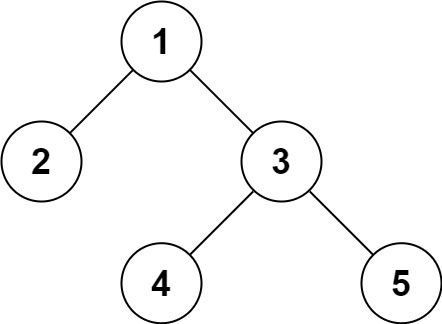Problem 297 Serialize and Deserialize Binary Tree
Table of Contents
Problem Statement
Link - Problem 297
Question
Serialization is the process of converting a data structure or object into a sequence of bits so that it can be stored in a file or memory buffer, or transmitted across a network connection link to be reconstructed later in the same or another computer environment.
Design an algorithm to serialize and deserialize a binary tree. There is no restriction on how your serialization/deserialization algorithm should work. You just need to ensure that a binary tree can be serialized to a string and this string can be deserialized to the original tree structure.
Example 1

Input: root = [1,2,3,null,null,4,5]
Output: [1,2,3,null,null,4,5]
Example 2
Input: root = []
Output: []
Constraints
- The number of nodes in the tree is in the range `[0, 10^4]`.
- `-1000 <= Node.val <= 1000`
Solution
/**
* Definition for a binary tree node.
* struct TreeNode {
* int val;
* TreeNode *left;
* TreeNode *right;
* TreeNode(int x) : val(x), left(NULL), right(NULL) {}
* };
*/
class Codec {
public:
string serialize(TreeNode* root) {
string ans = "";
TreeNode* temp = root;
queue<TreeNode*>q;
q.push(temp);
while(!q.empty())
{
for(int i = 0; i<q.size(); i++)
{
if(q.front() != nullptr)
{
ans+=to_string(q.front()->val);
ans+='#';
q.push(q.front()->left);
q.push(q.front()->right);
}
else
{
ans+="null#";
}
q.pop();
}
}
return ans;
}
TreeNode* deserialize(string data) {
vector<string> nodes;
int l = 0, r = 0;
while (l < data.size()) {
while (r < data.size() && data[r] != '#') {
r++;
}
nodes.push_back(data.substr(l, r - l));
l = r + 1;
r = l;
}
if(nodes[0] == "null")
return nullptr;
TreeNode* root = new TreeNode(stoi(nodes[0]));
queue<TreeNode*>q;
q.push(root);
int ind = 1;
while(!q.empty())
{
TreeNode* curr = q.front();
q.pop();
if(nodes[ind]!="null")
{
TreeNode* temp = new TreeNode(stoi(nodes[ind]));
curr->left = temp;
q.push(temp);
}
else
{
curr->left = nullptr;
}
ind++;
if(nodes[ind]!="null")
{
TreeNode* temp = new TreeNode(stoi(nodes[ind]));
curr->right = temp;
q.push(temp);
}
else
{
curr->right = nullptr;
}
ind++;
}
return root;
}
};
// Your Codec object will be instantiated and called as such:
// Codec ser, deser;
// TreeNode* ans = deser.deserialize(ser.serialize(root));
Complexity Analysis
Time Complexity: O(n) where n is the number of nodes in the tree.Space Complexity: O(n) where n is the number of nodes in the tree.
Explanation
1. Intuition
1. Serialization :
- We can serialize a binary tree using level order traversal.
- Use a queue to store the nodes of the tree.
- If the node is not null, push the value of the node to the string and push the left and right child of the node to the queue.
- If the node is null, push "null" to the string.
- Use an appropriate delimiter to separate the values of the nodes.
2. Deserialization :
- Split the string using the delimiter and store the values in a vector.
- Create a queue and push the root node to the queue.
- Iterate over the vector and create the left and right child of the current node.
- Push the left and right child to the queue.
- Return the root node.
2. Implementation
1. Serialization :
- Initialize a string `ans` and a queue `q`.
- Push the root node to the queue.
- Iterate over the queue and check if the front of the queue is not null.
- If the front of the queue is not null, push the value of the node to the string and push the left and right child of the node to the queue.
- append the delimiter `#` to the string.
- If the front of the queue is null, push "`null#`" to the string.
- Return the string.
2. Deserialization :
- Split the string using the delimiter `#` and store the values in a vector `nodes`.
- If the first element of the vector is `"null"`, return `nullptr`.
- Create a root node with the value of the first element of the vector.
- Create a queue `q` and push the root node to the queue.
- Initialize an index `ind` to 1.
- Iterate over the queue and create the left and right child of the current node in the following manner
- If the value at index `ind` is not `"null"`, create a new node with the value and assign it as the left child of the current node.
- Push the left child to the queue.
- Increment the index `ind`.
- If the value at index `ind` is not `"null"`, create a new node with the value and assign it as the right child of the current node.
- Push the right child to the queue.
- Increment the index `ind`.
- Return the root node.
Picture credits : LeetCode